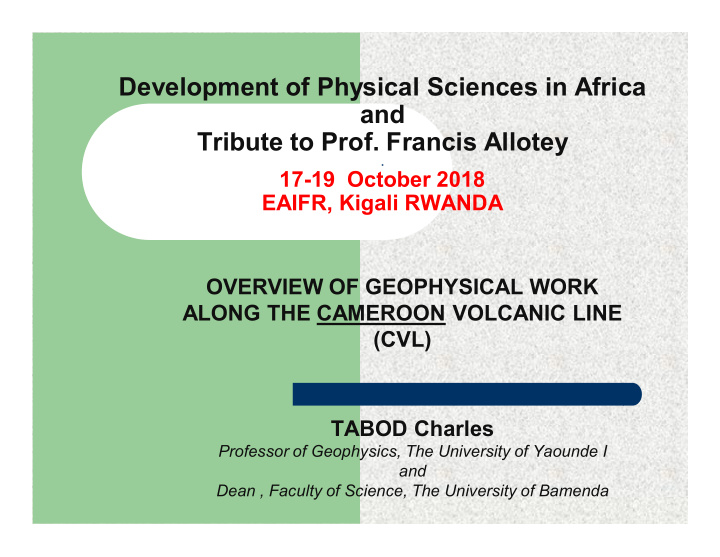



Development of Physical Sciences in Africa and Tribute to Prof. Francis Allotey . 17-19 October 2018 EAIFR, Kigali RWANDA OVERVIEW OF GEOPHYSICAL WORK ALONG THE CAMEROON VOLCANIC LINE (CVL) TABOD Charles Professor of Geophysics, The University of Yaounde I and Dean , Faculty of Science, The University of Bamenda
PLAN � Introduction � Work covering the CVL � The Congo Craton � The Sedimentary Basins � The Adamawa Fault Zone � The Highlands of South-western Cameroon
THE CAMEROON VOLCANIC LINE
Introduction � We have used geophysical techniques to improve on man ’ s scientific knowledge of the subsurface and the search for water in Cameroon. The principal methods of investigation we have used include: � Gravity � Geoelectricity � Audio-Magnetotellurics � Seismology
Introduction � Our research work has been carried out both over the whole of Cameroon and in specific regions of Cameroon: � Congo Craton � Sedimentary basins � Adamawa Fault Zone, and � Highlands of south-western Cameroon � This work has generally been carried out with colleagues in the Universities and research institutes and Masters and PhD students
Introduction Location of case study areas Case study regions from north to south: N � Yagoua basin � Garoua basin � Adamawa plateau � Mamfe basin � Douala basin � Congo Craton
Work covering the CVL: Seismology Felt earthquakes of magnitude > 3.5, since 1852 Fairhead, 1985 � � Ambraseys and Adams, 1986 � Ambeh et al., 1989 � Tabod et al., 1992 � Ateba et al., 1997 � Ntepe et al., 2004 � Tokam et al., 2010
Work covering the CVL: Seismology Instrumental Seismicity Ngatchou et al., 2015 � Seismicity mainly around the Mt. Cameroon volcano and predominantly strike-slip movement along faults
Work covering the CVL: Seismology Broadband network 32 broadband seismic stations � Reusch et al., (2009) using P and S arrivals � from teleseismic events performed a tomographic study of the Upper Mantle across Cameroon. Tokam et al ., (2010) used joint inversion of � Rayleigh wave group velocities and receiver functions to show that crustal thickness Fishwick, (2010) used the surface waves � tomography Gallacher and Bastow (2012) stacked � receiver functions to study crustal structure Guidarelli and A. Aoudia (2016) Inverted � Rayleigh waves lithospheric structure.
Work covering the CVL : Gravity Marcel et al (2018) upward � continuation, horizontal gradient and Euler deconvolution techniques Marcel et al . (2016) Moho � discontinuity depth along the CVL and found values ranging from 19 to 34 km Kamguia et al., 2005. The first � geoid model for Cameroon (CGM05) has been determined using both land and offshore gravity data
The Congo Craton � The deep structure across the Congo Craton and the Pan-African mobile belt is modelled using gravity data � Owona et al. (2011) Found crustal thicknesses of up to 45 km � Tadjou et al. (2009) Found mean Moho depth of about 47 km across the Congo craton and the Pan- African fold belt
The Sedimentary Basins Yagoua, Far North Cameroon � Njandjock et al., 2006 Sediments in the Yagoua basin in the far north of Cameroon found to be about 3 km from the Maroua spectral analysis of gravity data Yagoua
The Sedimentary Basins Garoua, North Cameroon � Kamguia et al., 2005 Garoua Basin The thickness Sediments found to be about 4 km � The continental crust below the basin is also found to be thinner (about 24 km) than the normal crust
The Sedimentary Basins Mamfe, South West Cameroon � Ngando et al., 2004 The results reveal the existence at depth attributed to water saturation. From audio- Mamfe magnetotelluric surveys A1
The Sedimentary Basins Douala/Kribi, Littoral Using gravity, � Ndikum et al., 2017, Ndikum et al., 2014, Koumetio et al., 2014 and Owona et al., 2011 found crustal thicknesses of 28 km and two separate blocks of less than 26 km with very low density contrast.
The Adamawa Fault Zone and the Highlands of South Western Cameroon � Bouba et al., 2017 � Jean Marcel et al., 2016 � Noutchogwe et al., 2006 � Kande et al., 2006 Results from gravity suggest the presence of a dense intrusion of probably basaltic composition at about 8 km and which may be related to the Cameroon Volcanic Line .
Thanks for your kind attention Some field work pictures
Recommend
More recommend